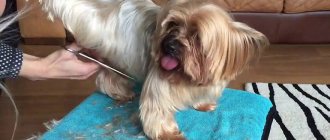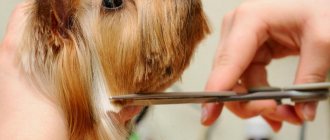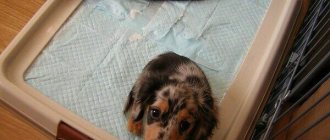Do you know how you will spend the next 15 years?
If you want to get a dog, add 15 years to your current age. In the best case, you will have exactly that amount when the dog grows old happily and calmly and leaves the world. What will you be doing these years? Are you planning to move in with your partner? Are you thinking about the child? Can you be called to work abroad?
All these questions need to be answered right now.
|
Are you sure you have no allergies?
Unfortunately, allergies are one of the reasons why dogs end up in a special detention center at best, or on the street at worst. You or your family members may be allergic to animal fur or skin. Even if you have never noticed it, when you come to visit those who already have a dog. Even if you had a dog as a child and were not allergic to it.
To determine if you have an allergy, there are two options. The first is to get tested. The second is to adopt a dog for a couple of weeks from friends. This way you will not only understand whether you have allergies or not, but also experience all the delights of living with an animal.
|
Do you really have time?
You need to walk your dog twice a day. If we are talking about puppies, then four times. You will have to go outside in any weather - rain, hail, blizzard, snow, 35 degrees below zero. Doesn't matter. We need to go for a walk.
The optimal walking time is half an hour. But this norm does not work for all breeds - for example, huskies need at least two hours of active exercise a day: running, training, playing with other dogs. Otherwise, the dog will get bored, chew furniture and walls, and may even become depressed.
If you think that getting up half an hour earlier is not a big deal, then add to this the time for feeding and daily washing, which twice a year - in autumn and spring - turns into a separate quest.
|
Role of parents
Wanting to get the long-awaited pet, the child tearfully assures mom and dad that he will take care of the puppy on his own. However, one should not succumb to illusions: a teenager is simply not able to independently perform all the functions of a dog owner, including visits to the veterinarian and purchasing food. Thus, even in the family of the most conscientious young dog breeder, the main difficulties and financial expenses fall on the shoulders of the parents.
Children instinctively adore everything small and fluffy, so a funny, thick-footed puppy will initially cause a storm of delight. A little later, the emotions will subside, and the child will understand that a living dog cannot be turned off after playing enough and put away in a box with toys. Children who are not accustomed to responsibility will begin to feel irritated, especially if their parents persistently remind them of promises to “feed, drink, and walk.” And here mom and dad need to show the skill of a psychologist in order to unobtrusively make everyday care of the pet desirable and enjoyable for the young owner.
For example, you can create a walking schedule: the mother walks the dog early in the morning to let the child sleep longer, but the evening walk is entirely up to the owner. In order for the child to feel proud of his pupil, provide the dog with a pleasant appearance: the whole family choose shampoo and bathe the puppy, take it for trimming and haircut, buy clothes and capture happy moments in the photo. If the dog gets sick, drop everything, find the best veterinarian and do everything not to lose your pet.
Don’t brush it off when your child enthusiastically tells you about his first training lesson or asks you to pay for a young handler’s course. Don’t refer to being busy or tired and don’t hide behind the phrase: “I don’t have time. It’s your dog, so do it.” Remember: in response to your indifference, a wall of misunderstanding will arise, and the child will feel lonely, and the dog will turn from a pet into a source of irritation and problems.
If at a family council you decide to acquire a tailed friend, then treat this very responsibly. Starting from choosing a dog breed that loves children to daily sharing with a son or daughter, all the worries and troubles.
Do you know where you will be walking?
It seems complicated - I took the dog, a leash and went for a walk. A couple of laps around the house and you can return. In fact, this is a picture from childhood. Now the reality has changed - walk around your home and pay attention to the signs on the lawns. Most likely, walking dogs is prohibited there.
They don't like violators. Especially those who don't clean up after animals. And if some express dislike with words, others spread poison across lawns and parks.
You can let your animal off the leash in uncrowded places or in special areas for dogs. There are few of these in the city, so finding one that is close to home can be a problem. Residents of the Rassvetny residential complex, where we filmed the dogs for illustrations for this text, were lucky in this regard: the developer, LSR Group, organized a dog walking area on the territory of the complex.
|
Are you ready for new expenses?
Firstly, the dog itself, if you decide to take it from a breeder and not from a shelter, is expensive. Secondly, your monthly expenses will increase. The main one is food. An average-sized dog on average eats 2 thousand rubles worth of average-priced food per month. Goodies and delicacies will cost another half thousand. Not monthly, but periodically you will have to update collars, leashes and toys.
Thirdly, both regular (for vaccinations and monitoring of previously known diseases) and unscheduled visits to the veterinarian cost a lot. For example, every year the dog will need to be protected from ticks. And this is another 1–1.5 thousand rubles in expenses.
Plus, most likely, while the dog is still a puppy, you will have to attend training classes. They cost the same as a lesson with a tutor - about a thousand rubles per hour. You are unlikely to get by with just one workout.
In addition, some breeds require grooming. Well, if you decide to participate in exhibitions, it will be a completely different story. You will have to pay both for participation in competitions and for the work of the dog handler and handler who will prepare for them.
|
Should you get a dog if you work?
We have already found out that a dog requires time, but a working person often has little time. And there is no escape from daily walks, not to mention other mandatory care procedures. Therefore, it is advisable to soberly assess your strengths in advance. You may be working, but one of your family members is ready to help you with your pet. If not, choose dogs that don’t get too bored away from their owners and don’t need long walks.
And for a working person, a dog will be an excellent “living alarm clock” and a guarantee that he will never oversleep on his way to work.
What about the new rules of life?
Before a puppy appears in the apartment, the space needs to be adapted. Prepare for the fact that in the first months the dog’s toilet will be in the apartment, and not always in a diaper. In addition, food cannot be left on the table, and garbage bags will have to be hidden in a bin with a lid, otherwise in the morning there will be leftovers lying around the apartment in an even layer.
Most likely, a cute puppy will quickly cease to be so as soon as he chews his favorite sofa, sneakers and baseboard. Get ready to change your lifestyle: put things back where they belong and remove anything that might be of interest to the puppy. Well, if you forgot to do any of this, get ready not to be upset. Well, or at least not much.
The new rules of life apply not only to the time when the dog is small. At a minimum, think about who you will leave your dog with when you go on vacation.
|
About illnesses
In addition to the mental health of dogs, their immunity is now also suffering, and the overall level of animal health is falling. “Many breeds already carry genetic diseases. Plus, unfair breeding has an impact. There are cases when a dog suffers from some incurable diseases, say skin diseases, but they are bred, and all this is passed on from generation to generation. As a result, weak immunity is established,” notes Anna.
Cases of cancer are now more common in animals. But, perhaps, because pets have begun to live longer: after all, they receive good care, nutrition, and medicine has advanced, the detection of oncology has increased. And oncology is more often recorded in older animals.
By the way, unscrupulous doctors sometimes play on the emotions of the owners. “Veterinary medicine, especially in expensive clinics, is often just a business,” says Evgeniy. – We must look for an honest and decent doctor. Otherwise, you will end up with such complex diagnoses for a huge amount of money.
These are just unscrupulous people. They promise to cure a dog or cat of cancer for an insane price, knowing that in reality there will be no cure. “So many people find themselves in such situations because they are ready to do anything for their beloved pet.”
Is mating necessary for an animal? Is it true that this is useful and also strengthens the dog’s working character? This is another myth, our interlocutors note. “They say, ‘breed a bitch for your health,’” says Anna. – This is a stupid reasoning: pregnancy and childbirth are in any case a burden and serious tests. There are problems during childbirth, illnesses in the animal during the postpartum period, large losses of calcium, heavy shedding after feeding puppies. When dogs are bred constantly, their udders sag and their backs sag.”
And this does not affect “cancer prevention” in any way, as some owners also think. If cancer is meant to happen to an animal, it will happen. Therefore, if the owners really want to take care of their animal, it is better to sterilize it if there is no goal of getting offspring.
In addition, abroad, for example, recalls Evgeniy, all working service dogs are required to be neutered. The same applies to guide dogs. After all, they undergo the highest level of training. What will happen if a working dog suddenly rushes on the trail of a female dog in heat, obeying his instincts, or a dog accompanying a blind person rushes towards a passing dog? This cannot be allowed.
“Sterilization or its absence does not affect the working qualities. The animal remains active. For example, sterilized cats are just as good at catching mice as unsterilized ones, if they have the ability to do so,” says Anna.
And now pets have become prone to obesity. Apparently, these are the consequences of the increased income of pet owners, Anna believes. Animals are fed out of great love, and because there is such an opportunity.
And again, these issues reflect the irresponsibility of the owners. It seems impossible to them to refuse a dog or cat who begs for food while looking into their eyes. And then animals develop, for example, pancreatitis or something else.
And what about the fact that you can avoid becoming a favorite?
Each dog breed has its own characteristics. Both physiological and psychological. They are written about in canine books and on the Internet - it’s easy to find out. But you will never know what your animal's personality will be. The dog can be flexible or independent, calm or energetic, but in any case he will have his own tastes and needs - and they will need to be accepted.
The animal will probably choose a favorite in the family and will listen to him first of all - most likely, this will be the person who feeds the pet and cares for it. But sometimes the choice of a “favorite owner” turns out to be not obvious, so if you have been dreaming of a dog for years, and she chose not you as her favorite, you just have to accept it.
Making a dog playground for a developer on the territory of his residential complex is not the easiest task for a developer: there is a set of strict rules and restrictions on where it can be located. LSR Group managed to build such a site on the territory of the Rassvetny residential complex. Its area is just over 600 square meters. m. It is fenced around the perimeter, and all residents of the residential complex can use it. Its covering is made of wood chips, an environmentally friendly material that does not have a negative impact on the environment and is harmless to humans and animals.
Very soon the last house will be built in the residential complex, near which the improvement of the territory of the complex will continue. By the way, the cost of apartments in a new building now starts from 2.16 million rubles.
Indoor decorative and other small breeds of dogs for apartments
This category includes dogs whose height at the withers does not exceed 40 cm.
Yorkshire Terrier
This dog is rightfully considered one of the best four-legged companions, ideal for apartment living. The dog has a serious character, inherited from its larger relatives. He is completely fearless, smart, active. Yorkies have the most tender feelings towards household members, and at the same time consider themselves the masters of the home. They are characterized by cleanliness and no dog smell. These beauties practically do not shed, and they are quite easy to train to the tray.
Yorkshire Terrier
Chihuahua
The smallest dogs on the planet are divided into long-haired and short-haired. Compared to other toy breeds, Chihuahuas are quite calm and balanced. However, this little one is very easy to get angry if a real or imaginary threat to his beloved owner appears. The most tender feelings for the owner of a Chihuahua are accompanied by excessive jealousy. A dog constantly needs manifestations of its owner's love, care, attention; loneliness is unbearable for it. Safe conditions must be created in the apartment for a fragile pet.
Chihuahua
French Bulldog
Loyal, affectionate, calm and at the same time brave, this miniature heir to fighting dogs does not need special care or long walks, but does require training. French bulldogs are very smart, they do not bark over trifles, but they will warn the owner about danger. It is worth considering that these dogs cannot tolerate heat at all, so you need to arrange a room in the apartment where it would be cool in the stuffy summer. It is better for neat and squeamish people not to have a representative of this breed, or at least not to let him reign in the bedroom: French bulldogs are prone to flatulence, often snore, and drool.
French Bulldog
Maltese (Maltese)
A charming long-haired representative of one of the oldest European breeds, she is a friendly and affectionate creature with a fairly docile character. However, when they try to raise lap dogs, they begin to act up. These dogs are characterized by excessive suspicion of strangers - at the sight of a stranger they usually burst into hysterical barking. Maltese are sociable, inquisitive, and able to easily adapt to the character of their owner. They love to eat delicious food, and it is not possible to train them to follow commands without a tasty reward. The silky straight coat of Maltese dogs is practically devoid of undercoat. Dogs hardly shed, but it is advisable to brush them daily.
Maltese (Maltese)
Russian toy terrier
Even in the most spacious apartment, this touching baby manages to fill the entire living space. Toy terriers are incredibly energetic, playful and playful. Anything can excite these dogs, but they are not easy to calm down. Those who choose this breed will often have to “enjoy” the boisterous bark of the animal. This drawback is offset by the incredibly positive energy of the toy terrier, which can improve the mood of any household member. The breed's strengths also include courage, ingenuity and exceptional memory.
Russian toy terrier
Pembroke Welsh Corgi
Extremely active and devoted favorites of the British royal family are the heirs of herding dogs. Instincts make themselves felt, and even in an apartment, corgis always try to settle in a “strategic position” that allows them to keep all household members under control. If one of the younger generation of his “herd” moves erratically, the Corgi may well lightly bite the offender on the leg or heel. This is not dangerous, but it is better to wean your dog off this habit immediately. Welsh Corgis have authoritative vocals - they bark no less loudly than their larger relatives. Owners have to put up with not only the expressive barking of their pet, but also the fact that he expresses his thoughts and demands by whining, grunting, sniffling and muttering. The corgi’s inherent “talkativeness” is offset by such advantages as love of life, fearlessness, endurance, agility, love for children and, of course, a charming appearance with a smiling face.
Pembroke Welsh Corgi
Pekingese
Smart, fearless and somewhat arrogant, Pekingese are one of the most popular representatives of indoor breeds. The main difference between this dog and most of its miniature relatives is its pronounced sense of self-esteem. Pekingese are independent, independent, do not claim constant attention from their owners and can easily tolerate loneliness. They will not disturb the peace of their owners with obsessive pestering and barking for no reason, which is why older people often choose them as companions. Pekingese treat their owners with love and respect, always feel their mood and behave accordingly. The former favorites of the Chinese emperors will not make a mess in the apartment, spoil the furniture and get underfoot. They are not very active and can easily do without regular walks. However, this is fraught with puddles on the floor - furry aristocrats do not favor litter boxes.
Pekingese









